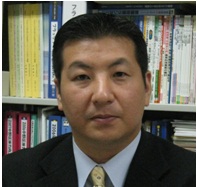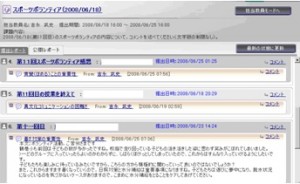03-05. Expanding Education Possibilities by Adapting Course N@vi to Suit Individual Course Types
Takeshi Yoshinaga
Assistant Professor, Faculty of Sport Sciences
Assistant Professor Yoshinaga, a member of the Faculty of Sport Sciences, actively uses Course N@vi for report submissions and for digital content for out-of-class study in omnibus courses that he co-teaches with other faculty members. Since he stated that “Course N@vi is extremely effective in achieving better learning outcomes,” we asked him about the specific advantages of the system.
Efficient management of hundred of reports in courses taught by multiple faculty members
The very first course Assistant Professor Yoshinaga used Course N@vi with was Introduction to Sport Sciences. This course involves basic sports education and training and is a required subject for all first-year students at the School of Sport Sciences.
This course is an omnibus course consisting of 12 themes selected from across the School of Sport Sciences. Different faculty members lecture on their specialty. Students write reports on any three themes they choose from the 12 themes and submit all the reports via Course N@vi.
Each faculty member grades reports written on his or her lecture theme, but Assistant Professor Yoshinaga is in charge of compiling the grades. “There are about 500 students in the course and each student submits three reports, meaning I have to deal with about 1,500 reports. And because there are many teachers grading reports, managing all this on paper is a very hard task. Having the students submit all their reports via Course N@vi makes my management work dramatically more efficient.”
Faculty members who frequently travel abroad really like the system because they can mark reports from anywhere with access to Course N@vi. “Unlike paper, there is no fear of losing reports, and there are no concerns about data being deleted that you would have if everything were stored on your own PC. Many teachers feel that the key benefit of Course N@vi is the peace of mind they get from having reports stored on a server.”
Provide classroom lectures as on-demand classes for absent students and for review purposes
The course’s classroom lectures are recorded on video and uploaded to Course N@vi one week after the lecture. At the School of Sport Sciences, some students cannot attend every lecture because of overseas trips and competitions. These students are accommodated by treating the accessing and viewing of a lecture video on Course N@vi as equivalent to attending the lecture.
The lecture videos on Course N@vi not only accommodate absent students; they are probably used more often for review purposes by students who attended the lectures. “It seems many students view the lecture videos to cram just before the end-of-term examinations. There are also signs that students repeatedly view classes on a subject of interest to help them choose their second-year courses.”
A superb means for students who are involved in separate activities to share information
Course N@vi was employed as a tool for information sharing among students in Sports Volunteering, a course run last year by the Open Education Center. In this course, students were divided into groups and placed in four Shinjuku Ward elementary schools where they served as volunteers. Sharing the activities the groups were developing at their own locations using Course N@vi made a huge difference in the effectiveness of the course.
Since the students in this course work apart in groups and since all students never gather in one place, they have no idea what kind of activities the other groups are pursuing. In response to calls from students who wanted to know what other groups are doing, the faculty members had each group share information by posting and exchanging reports partway through the course. Almost immediately, the students were seen giving each other advice on what kind of instruction to give in certain situations or how best to address elementary school students. Others were seen incorporating practices from other groups — such as mini athletic meets or sports festivals — into their own activities.
The students in this course came from all different undergraduate schools. Many took the course because they were simply interested in volunteering rather than seeking to be teachers. After these students came in contact with elementary school children and realized how difficult teaching actually is, being able to see what other groups were doing and to hear their opinions was a big help in overcoming concerns about not having enough ideas.
The students became friendlier with each other as they exchanged information online even without meeting face to face. When they did finally gather for a discussion at the end of the course, it was very exciting for the participants. The students themselves valued Course N@vi because it let them refer to the activities of other groups.
In a questionnaire after the course finished, students said they were extremely satisfied with the course and many stated they would like to volunteer again if the opportunity arose even if not for a course. “If we had not introduced information sharing with Course N@vi, I doubt we would have been able to generate such positive learning outcomes.”
As this course has demonstrated, the introduction of Course N@vi as an information-sharing tool for students involved in far-flung field work can have a profound effect on the effectiveness of the course.
Record videos of simulated classes as data for analyses
Based on his experiences so far, Assistant Professor Yoshinaga took on a new challenge last year: using digital content as part of a teacher-training program at a graduate school. The best way to educate physical-education teachers is to have classes in real teaching environments and to study by observation to develop their teaching execution skills. In practice, however, setting up such opportunities is difficult. As a result, Assistant Professor Yoshinaga runs simulated classes where students take on the roles of teachers and pupils and records videos of the proceedings. After the simulations, he has the students analyze the videos.
“What words do teachers use to address their pupils? We make notes about the words used — whether they convey praise or advice or negatives — and how often they are used. We know that a good class consists of a lot of advice, mixing praise and technique corrections, but I have students note on an observation sheet how often this advice is given and at what points in chronological order.”
Because the video analysis takes significant time, Assistant Professor Yoshinaga uploads the videos as digital content to Course N@vi and has the students access the videos and complete the analysis work outside of class. By comparing the class reviews by students playing pupils with the analyzed class notes on the observation sheets, Assistant Professor Yoshinaga can spot correlations between the two. He then tailors his in-class discussions and lectures around these correlations.
“There’s a limit to studying from notes alone. So this method has been extremely effective in raising students’ practical skills. I’m using a portion of this method this year in some of my undergraduate courses.” Because he cannot have undergrads take part in simulated classes, Assistant Professor Yoshinaga instead reuses the videos made last year — after getting the consent of the grad students — and guides the undergrads so they develop the same skills through the process of analyzing the videos. This experiment has proven very effective partly because students going on to be student teachers can form an image of what they will be doing by observing beforehand classes that are similar to real classes.
The advantage of digital content is that once it is created, it can be used over and over in subsequent years. “We have three videos at the moment, but I want increase this number quickly because if we can assemble content on various teaching patterns — such as a video focusing just on the pupils’ behavior or another showing a teacher instructing someone on a gymnastic technique — we can achieve even better outcomes.”
Paying attention to the public/private settings of information is vital
Although he actively uses Course N@vi, Assistant Professor Yoshinaga has a bitter memory from the time the system was first introduced. “When I was using OIC (On-demand Internet Class), the predecessor to Course N@vi, I accidentally disclosed report marks as I was grading them to the students. Because of that experience, I am now fastidious about checking public/private settings.”
Users can choose public/private settings and set access levels for individual pieces of information managed by Course N@vi. It is important, then, to be aware of the privacy settings for each piece of information — especially verifying that information, which might cause problems if made accessible to students, is set to “private.” “As soon as I made attendance and other information public so that students could check it on their own, I noticed an improvement in attendance rates.”
For Assistant Professor Yoshinaga, the biggest significance of Course N@vi is its ability to elevate the substance of courses. “It’s true, of course, that using Course N@vi is convenient because it saves time and labor. But beyond that, it enables many multidimensional aspects; things we couldn’t do in courses before, we can now do. I’m absolutely convinced that Course N@vi is an effective tool in eliciting greater learning outcomes.”
Tips on implementing Course N@vi
“Regardless of the type of course, there is always a method of using Course N@vi that will work with your course. I encourage everyone to abandon the idea that ‘it isn’t suited for my courses’ and actually give it a try.”
<Privacy setting window for reports>
Assistant Professor Yoshinaga lets students share information in the Sports Volunteering course by making both reports and comments from overseeing faculty members on the reports viewable by all students in the course.



